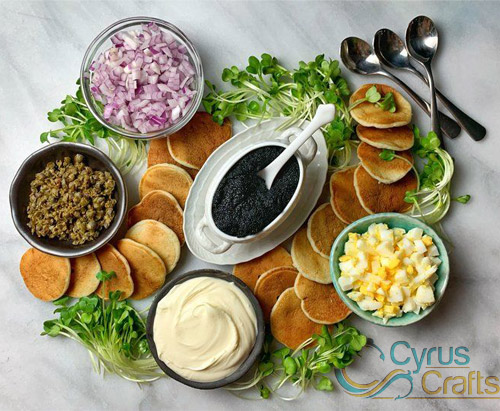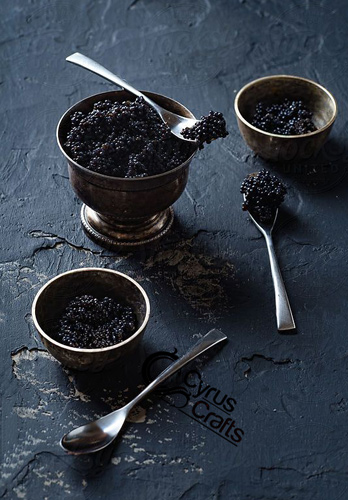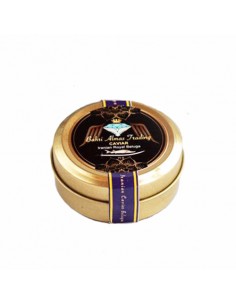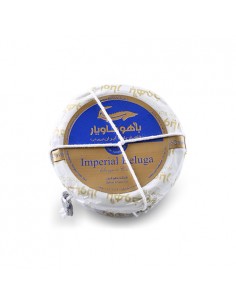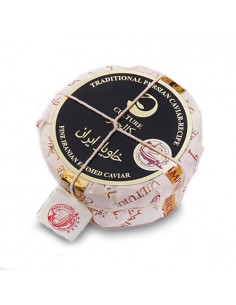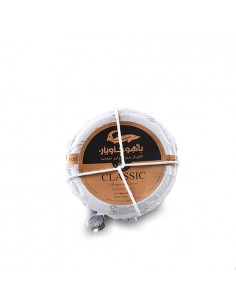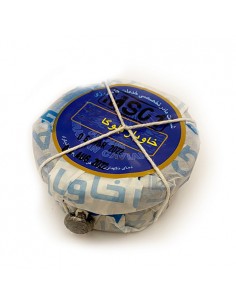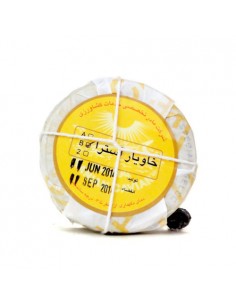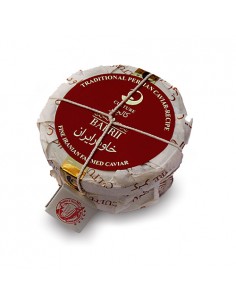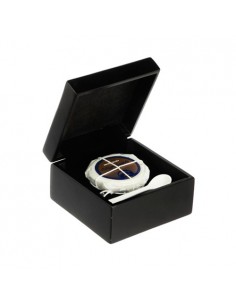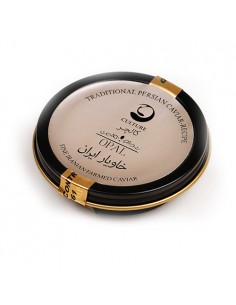Caviar
Caviar is known as a very beneficial food in the world. In this regard, Iranian Caviar is mentioned as one of the best Caviar in the world and the black pearl of the Caspian Sea. Find out more about Iranian caviar properties, features, maintenance methods, preparation methods, and comparisons with other countries in our tasty caviar section.
Caviar Review, Select, and Shopping Tips
Immerse yourself in the opulent realm of Caviar, a delicacy relished by connoisseurs across the globe. This voyage takes us from the mysterious depths of the Caspian Sea to the grandeur of aristocratic dining tables. This blog post will enlighten you on Caviar's enthralling history, intricate production process, and sustainable harvesting methods. Moreover, it will guide you in selecting and preserving this luxurious indulgence. Whether you're a seasoned caviar connoisseur or an adventurous food enthusiast, join us as we unravel the lavish mysteries behind this exquisite delicacy.
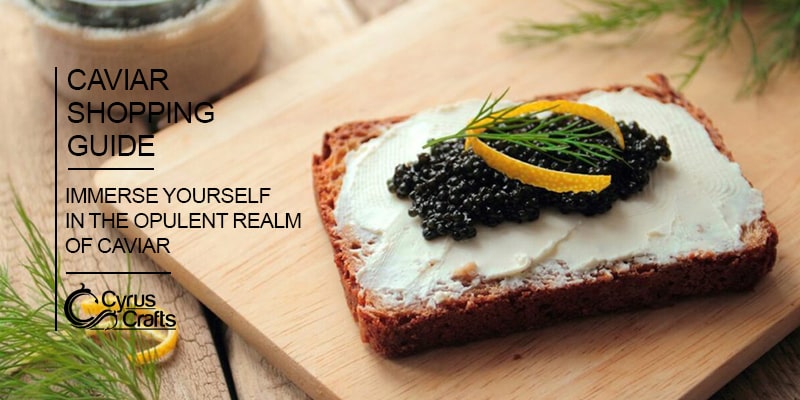
Cyrus Crafts; Luxury & Unique Products
What is Caviar?
Originating from the Persian term "khag-avar", which translates to "the roe generator", Caviar refers to the salt-cured eggs from the enigmatic sturgeon fish. This extravagant indulgence has been savored for centuries, with its roots embedded in ancient Persia and Russia. Originally a privilege bestowed upon royalty and nobility, Caviar has gradually become accessible to a wider audience.
The History of Caviar
Caviar holds a captivating history deeply rooted in the cultures and traditions of the Caspian Sea region. The ancient Persians were pioneers in appreciating the culinary delight of sturgeon roe, while the Russian tsars played a pivotal role in its popularization. During the 19th century, Caviar ascended to symbolize luxury, coveted by aristocrats and affluent individuals across Europe. However, the dawn of overfishing and illicit harvesting practices led to a downfall in sturgeon populations, necessitating sustainable caviar production.
Caviar Production Process
The production of Caviar is a delicate art that demands proficiency and exactitude. Chosen with great care, sturgeon fish provide precious eggs, from which the roe is tenderly extracted to avoid harm. The eggs are then cleansed and salted, amplifying their flavor and serving as a natural preservative. The curing duration fluctuates contingent on the desired taste and texture of the Caviar. The final stage involves packing the Caviar into tins and preserving them in climate-regulated conditions to uphold their superior quality.
Caviar Farming vs. Wild Caviar
In recent years, the cultivation of Caviar on farms has ascended in popularity, emerging as a sustainable contender to the practice of wild caviar extraction. These caviar farms offer a regulated milieu where sturgeon fish can flourish, ensuring a constant flow of Caviar without impacting the wild populations.
Moreover, the farm-bred Caviar guarantees a uniform quality and flavor profile, adding to its appeal. However, there exists a faction of purists who contend that the allure and intricate complexity of wild Caviar remains unrivaled by its farmed counterparts. This ongoing debate between advocates of caviar farming and wild harvesting proponents continues to shape this epicurean delight's destiny.
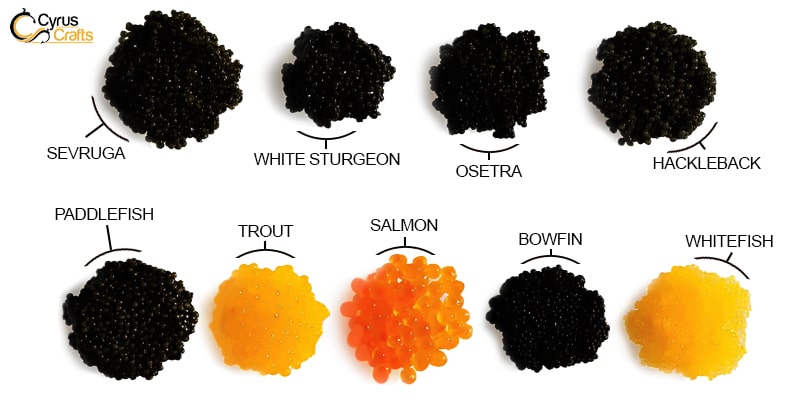
Types of Caviar
Although Beluga caviar is often hailed as the pinnacle of luxury, the world of Caviar is not limited to this kind of roe. There are other varieties, each offering a unique symphony of flavors and textures. The most celebrated varieties include Osetra, Sevruga, and Sterlet caviar. Osetra caviar serenades the palate with a nutty and buttery melody, while Sevruga caviar presents a more pronounced harmony. Sterlet caviar, being smaller, performs a subtle yet intricate composition. Each type of Caviar has its unique score, inviting connoisseurs to embark on a flavorful journey.
There are many different types of Caviar in the world, but all share one common trait – they are a luxurious treat. Among the best types of Caviar in the world, Iranian Caviar should thrill your palate. Iranian Caviar is one of the best in the world. There are several types of Caviar, including:
Beluga Caviar
The most luxurious Caviar in the world, Beluga caviar is the epitome of culinary sophistication. With large, pearlescent eggs of a light glistening grey, Beluga is prized for its smooth, buttery texture and a rich and subtle flavor that melts in the mouth. Almas caviar is an example of beluga caviar. The roe from the Almas sturgeon, a rare albino Beluga sturgeon, is one of the most exclusive Caviar today.
White Sturgeon Caviar
This is an excellent substitute for the world-renowned Osetra or Siberian Sturgeon. Its medium dark beads, mild taste, and clean buttery finish will be greatly appreciated by those whose palate is used to mildly flavored foods. Comparably moderately priced and excellent quality make it a preferable choice for a high-end event with many guests.
Baerii caviar
The Baerii caviar is known for its smooth and elegant appearance, with a refined grain that makes it immediately recognizable as the best quality. With its exquisite smoky flavor and velvety finish, this Caviar has been a favorite for decades.
Sevruga Caviar
Among all sturgeon species, the Sevruga from Acipenser Stellatus reproduces faster than other varieties of Caviar. These small and delicate grey-to-black eggs, with a crunchy texture, are a pleasure to bite into. While other types of this food dissolve in your mouth, Sevruga playfully crackles and pops with a more intense flavor.
Kaluga Caviar
Kaluga was initially produced from the huso Daricus sturgeon. These days, it is mainly farm-raised to ensure sustainability and quality control. One of the best Caviar in the world today, Kaluga caviar is creamy and smooth, with an almost buttery texture and a great firm pop. Combining all the beautiful characteristics of Beluga caviar, you can eat luxurious Kaluga eggs knowing you are consuming eco-friendly, sustainable Caviar of the highest quality.
Ossetra Caviar
Of the 27 sturgeon species, Osetra caviar is roe from the Sturgeon native to the Caspian Sea. Osetra caviar is known for its nutty, buttery flavor and roe color, ranging from deep amber to light amber and gold. Osetra caviar is particularly coveted for its golden color.
Hackleback Caviar
Caspian Sturgeon is another contender in place of the classic.
This Caviar Similar to the Sevruga caviar both in the size and texture of its eggs, Hackleback has small, firm eggs that are dark brown to black. Hackleback sturgeon has Caspian sturgeon's smooth and delicate flavor but is milder, with a little extra nutty punch.
The Difference Between Fish Roe and Caviar
Often, 'fish roe' and 'caviar' are used interchangeably. However, these two delicacies are as different as chalk and cheese. In its broadest sense, fish roe refers to the eggs or spawn of any fish species. Conversely, Caviar is a title bequeathed exclusively to the eggs of the sturgeon fish. While fish roe may come from many fish species, Caviar is an exclusive club derived solely from sturgeon, making it a more coveted and sought-after delicacy.
The distinctive texture and flavor of fish roe deviate from that of Caviar. Unlike the larger, homogenous caviar spheres, the former boasts smaller, irregular pearls. Caviar further distinguishes itself with a sophisticated flavor palette, delicately balancing salinity and creaminess. This gastronomic pleasure is largely due to the unique characteristics of sturgeon eggs, coupled with the intricate processing and maturation procedures that enhance the indulgent experience associated with Caviar.
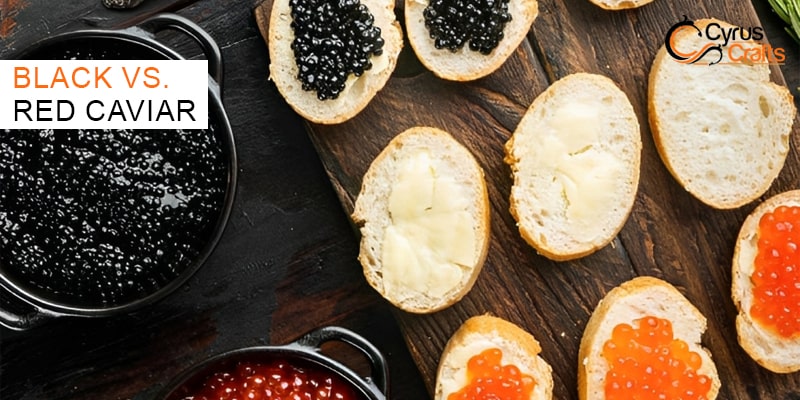
What is the Difference Between Black Caviar and Red Caviar?
Caviar stands as a shining star in luxurious indulgences, often inciting a common query: what distinguishes black Caviar from red Caviar? The term "black caviar" signifies the roe of the majestic sturgeon species, encapsulating variants such as the highly-revered Beluga, the distinctive Osetra, and the intense Sevruga. These illustrious types of Caviar are recognized by their dark palette, spanning from jet black to varying tones of gray and earthy brown. The symphony of flavors presented in black caviar changes with each variety: Beluga offers a gentler, buttery melody, Osetra delights with its nutty harmony, while Sevruga captivates with its pronounced briny overture.
In contrast, red Caviar is the glorious offspring of diverse piscine parents such as salmon, trout, and whitefish. This variant of caviar gleams with vibrant hues of red or orange, a testament to the natural pigments cradled in the roe. The flavor composition of red Caviar is unique, often characterized as a rich tapestry of slight saltiness interwoven with a subtle hint of sweetness. While black and red Caviar possess their unique charm, the age-old allure of black Caviar continues to hold a timeless appeal in the world of luxury.
What's the Difference Between Classic, Royal, and Imperial Caviar?
In your caviar expeditions, you may encounter such illustrious terms as 'classic,' 'royal,' and 'imperial.' These are not arbitrary classifications but denote the distinct grading of Caviar, a measure of the quality and size of the pearls. The 'classic' grade is bestowed upon the tiniest of eggs, a diminutive 1.5 to 2.5 millimeters in diameter. The 'royal' grade graces slightly larger orbs spanning 2.5 to 3.5 millimeters. As its majestic name would suggest, 'imperial' Caviar represents the largest and most luxurious of eggs, measuring over a grand 3.5 millimeters in diameter.
The choice between the classic, royal, and imperial varieties of Caviar ultimately hinges on personal preference and the nature of the occasion. With its delicate and understated flavor, the classic grade is splendid for pairing with other ingredients such as blinis or crème fraîche. With its more pronounced flavor and texture, Royal Caviar is the ideal selection for those yearning for a more decadent experience. And then, there's imperial Caviar. Its large, luxurious eggs embody opulence, often reserved for special occasions or discerning gourmands.
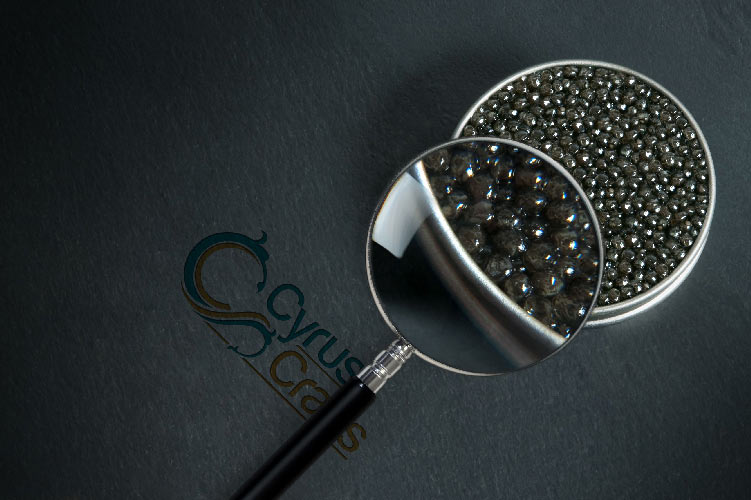
A Guide to Distinguish Real Caviar vs. Fake Caviar
If you buy Caviar, ensure it is real and comes from a reputable store. One such place is CyrusCrafts online shop; here, you can see different types of Caviar and prices and purchase your favorite confidently. Now, to identify the original Caviar, follow the tips below:
- Its seeds are originally grey and dull, while the counterfeit color is blacker and clearer.
- The original caviar grains are oval and sticky, while the counterfeit ones have smooth, round surfaces and a moist and vicious appearance.
- The original caviar package lists the veterinary code, production, expiration date, place of production, type of breeding conditions, and maintenance conditions.
Caviar is obtained from a type of starry sturgeon fish, which is the spawn of the female of this fish. This food is full of nutrients that have a more significant impact on human health. It is one of the best sources of antioxidants, and according to research, Caviar, due to its omega-3, in addition to preventing joint diseases, also prevents depression and cardiovascular diseases.
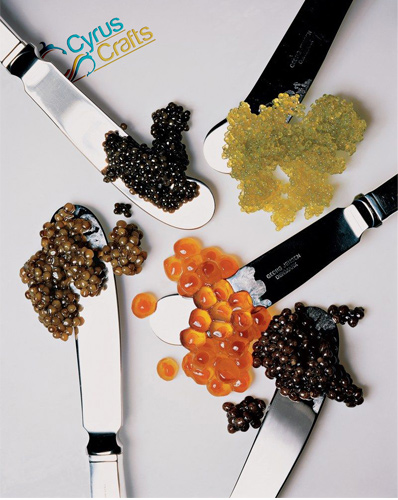
The Texture of Caviar
One cannot discuss Caviar without noting its emblematic texture. Renowned for its delicately firm constitution, each pearl of caviar bursts open in the mouth, unleashing a tidal wave of flavor. However, caviar texture is not a static characteristic; it alters depending on the type and quality of the roe. The large, butter-soft pearls of Beluga caviar offer a divine melt-in-your-mouth sensation. The slightly firmer texture of Osetra caviar gifts the palate with a gratifying burst. And Sevruga caviar's petite, robust eggs pack a punch, delivering a distinctly pronounced bite.
To truly relish Caviar's texture, a mother-of-pearl spoon or a non-reactive utensil is recommended, as metallic utensils can degrade the flavor. One can savor its distinctive texture and flavors by placing a modest dollop of Caviar on the tongue and permitting it to dissolve naturally.
What Does Caviar Smell or Taste Like?
Emerging from its shell, each grain of Caviar is a tale of flavor and aroma that varies as widely as a spectrum of colors. The highest quality caviar unveils a fresh scent akin to a gentle sea breeze, enamoring the senses with its briny charm. Its intriguing taste is a delightful dance of buttery richness, creamy decadence, and a touch of lingering salinity. These subtle nuances in taste, unique to each variety, make the experience of savoring Caviar an exquisite journey of discovery.
The texture and size of the eggs play a significant role in this gastronomic adventure. Larger eggs offer a bolder, more pronounced burst of flavor, adding an exciting dimension to the overall experience. To truly relish the multifaceted complexity that Caviar offers, it is recommended to indulge in this delicacy in its purest form.
Caviar Benefits
Caviar provides an endless list of benefits. Some of them include the following:
- Supply of essential antioxidants to the body
- Prevention of Alzheimer's and heart attacks
- Treatment of high blood pressure
- Increase body health
- Fight against various viruses
- Strengthen muscles
- Help treat depression
- Strengthen bones
- Coping with stress and migraines
- Beautify and strengthen the skin
- Strengthen the kidneys and liver
- Cancer prevention
Caviar Benefits for Children
Caviar is one of the best foods for children due to its higher omega-3 content than other foods, the presence of vitamins A, D, K, and iodine, and the helpful fatty acid DHA, which significantly impacts their growth and intelligence.
Nutritional Value of Caviar
Good daily-value percentages of calcium, iron, magnesium, and zinc are found in Caviar. Zinc is more well-known as the mineral that boosts the immune system, often added to cough drops and cold remedies. "It helps your body make more white blood cells when needed and helps them release the necessary amount of antibodies when a "bad germ" is detected. Here is a table of the minerals in 100 grams of Caviar:
| INFORMATION | AMOUNT |
|---|---|
| Calories | 264cal |
| Protein | 25g |
| Sodium | 1.5g |
| Fat | 18g |
| Carbohydrate | 4g |
| Vitamin B12 | 20.00mg |
| Vitamin B6 | 0.320 mg |
| Vitamin A | 905.00 IU |
Everything About Storing Caviar
Preserving Caviar's exquisite quality and flavor hinges critically upon its storage conditions. The ideal temperature to uphold the freshness of Caviar lies between a frosty 28-32°F (-2 to 0°C). Caviar should be nestled in the chilliest corner of your refrigerator, perhaps the rear or within the crisp drawer.
Once the seal is broken, Caviar should be devoured posthaste within a few days to stave off spoilage. Swaddle your Caviar tightly in plastic wrap for a longer shelf life, ensuring no breath of air can sneak in. Be wary of freezing Caviar, as it can tamper with its texture and taste.
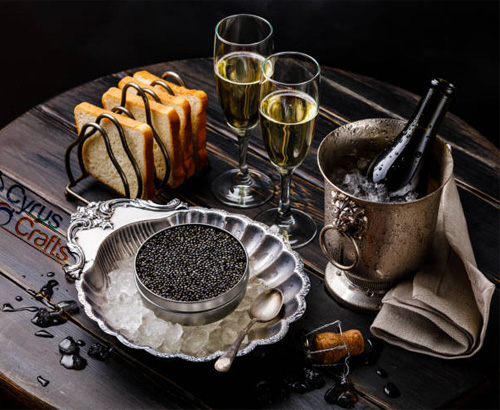
How Long Does Caviar Last?
Caviar, a perishable delicacy, does not enjoy the longevity common to other food items. Its freshness and quality can wane rapidly if not stored with care. Unopened Caviar can comfortably inhabit your refrigerator for up to four weeks, while once opened, it should be savored within a handful of days. It is paramount to maintain the chill of the Caviar between 28°F to 32°F (-2°C to 0°C) to preserve its freshness and deter spoilage.
Can You Freeze Caviar?
As previously highlighted, Caviar's longevity can be extended through freezing. However, it's worth noting that this process may subtly alter the texture of the Caviar, rendering it somewhat softer. If the prospect of freezing Caviar is under consideration, it's important to execute this operation correctly to mitigate any potential detractions from its premium quality.
How to Consume Caviar?
It is composed of vitamins and proteins, and the ingredients in Caviar contain 75% of the listing and 25% of the cholesterol. This food should be served cold and raw along with other foods. It is recommended to consume this beneficial and nutritious food at breakfast. The original Caviar can be used with eggs or boiled eggs, toast, and honey for breakfast or with pasta, shrimp, sushi, or any food that suits your taste in other meals. It can enhance the taste of Caviar by adding butter, pepper powder, and sour lemon juice. Cooking Caviar destroys its vitamins, so you should avoid it.
Comparison of Iranian Caviar with other Countries
Iranian Caviar has incredible texture and heavenly taste, making it the best in the world, unlike other types, such as American Caviar. Most famous hotels and restaurants worldwide mention Iranian Caviar as a particular part of their menu. Despite its competitors, such as China and Russia, it has a special place worldwide. Iranian Caviar is exported to the European Union, Asia, Australia, the United States, and Canada. This product is so popular that some countries pre-purchase it.
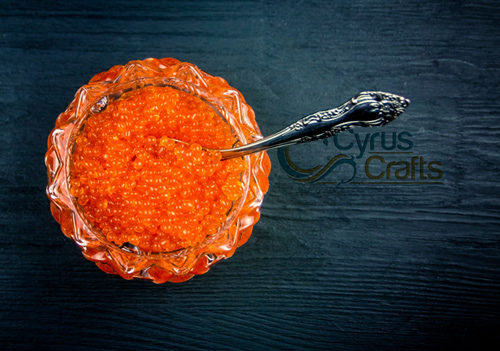
Caviar Breeding Conditions
According to caviar producers, the ideal temperature for fish farming is between 15 and 27 degrees Celsius. If the temperature is less than 6 degrees Celsius, feeding will stop, and its growth will slow. Temperatures between 19 and 21 degrees Celsius are the best temperatures for this species to grow. Salinity should be between 4 to 10 grams per liter of water.
Proportional oxygen is between 6 to 8 mg per liter of water, carbon dioxide is less than 10 mg, and The pH of the water should be between 5.8 and 7. For many years, authentic Iranian Caviar has been exported to different parts of the world, such as the United States and Canada. This is happening globally due to the capabilities and available knowledge in the Cyruscrafts collection in the best types of Caviar and prices.
The Price of Caviar
Iranian Caviar is one of the most expensive and, of course, the most delicious and energetic foods globally, with a natural taste and almost no additives.
In addition to its unique and delicious taste, this tasty Iranian food is one of the most valuable foods in the world, used to prevent many diseases. However, due to sturgeon's extinction risk, their fishing has been limited in recent years. Because of that, some kinds of original Iranian Caviar can exceed $5,000 per kilogram!
25% of caviar fat is cholesterol, and 75% is lecithin. Arginine, histamine, isoleucine, lysine, and methionine comprise its protein.
Types of Caviar: Price Comparison
In the lavish world of gourmet foods, many caviar varieties await, each imbued with enchanting qualities and price tags. This realm's most renowned and coveted triad is the Beluga, Osetra, and Sevruga caviars. Beluga caviar, previously mentioned, is celebrated for its generously sized roe and a flavor that dances on the tongue much like liquid butter. Born from the noble Osetra sturgeon, Osetra caviar is often revered as the pinnacle of indulgence, offering a compelling blend of nutty and creamy flavors. Sevruga caviar presents a different kind of allure with its petite eggs and salty undertones, providing a bold and robust gastronomic journey.
It's vital to weigh the quality and scarcity of the roe by comparing these caviar varieties' price tags. Beluga caviar, being the crème de la crème, naturally bears a lofty price. Osetra and Sevruga caviars, albeit still dear, are relatively more within reach. It is of utmost importance to conduct meticulous research and seek advice from trusted connoisseurs to ensure you receive the finest investment value.
How to Choose the Right Caviar
Choosing the perfect Caviar can seem like a Herculean task, given the abundance of choices. Factors to consider while selecting must include the breed of sturgeon, the size and hue of eggs, and, of course, the flavor profile. With its generous, light gray pearls and rich, buttery flavor, Beluga caviar is often lauded as the zenith of caviar luxury.
Osetra and Sevruga caviar provide a spectrum of flavors and textures, while the Sterlet caviar offers a more nuanced and subtle experience. Furthermore, the freshness and quality of the Caviar should be given due attention, as these elements significantly shape the overall flavor profile.
Popular Caviar Dishes and Recipes
Caviar is a remarkably versatile ingredient, lending itself to many dishes and recipes. From traditional pairings with delicate blinis and creamy crème fraîche to innovative concoctions like caviar-laden sushi rolls, the possibilities of indulging in this luxury are practically endless.
Caviar can also serve as a high-end garnish, enhancing dishes like scrambled eggs, pasta, and salads. Its unique salty and buttery flavor can add a dash of luxury to any culinary masterpiece. Whether you gravitate towards traditional recipes or experimental fusion cuisines, integrating Caviar into your culinary repertoire will impress the most discerning palates.
CyrusCrafts online store provides high-quality, original, and delicious Iranian Caviar that you can enjoy as food and profit from its health benefits.


